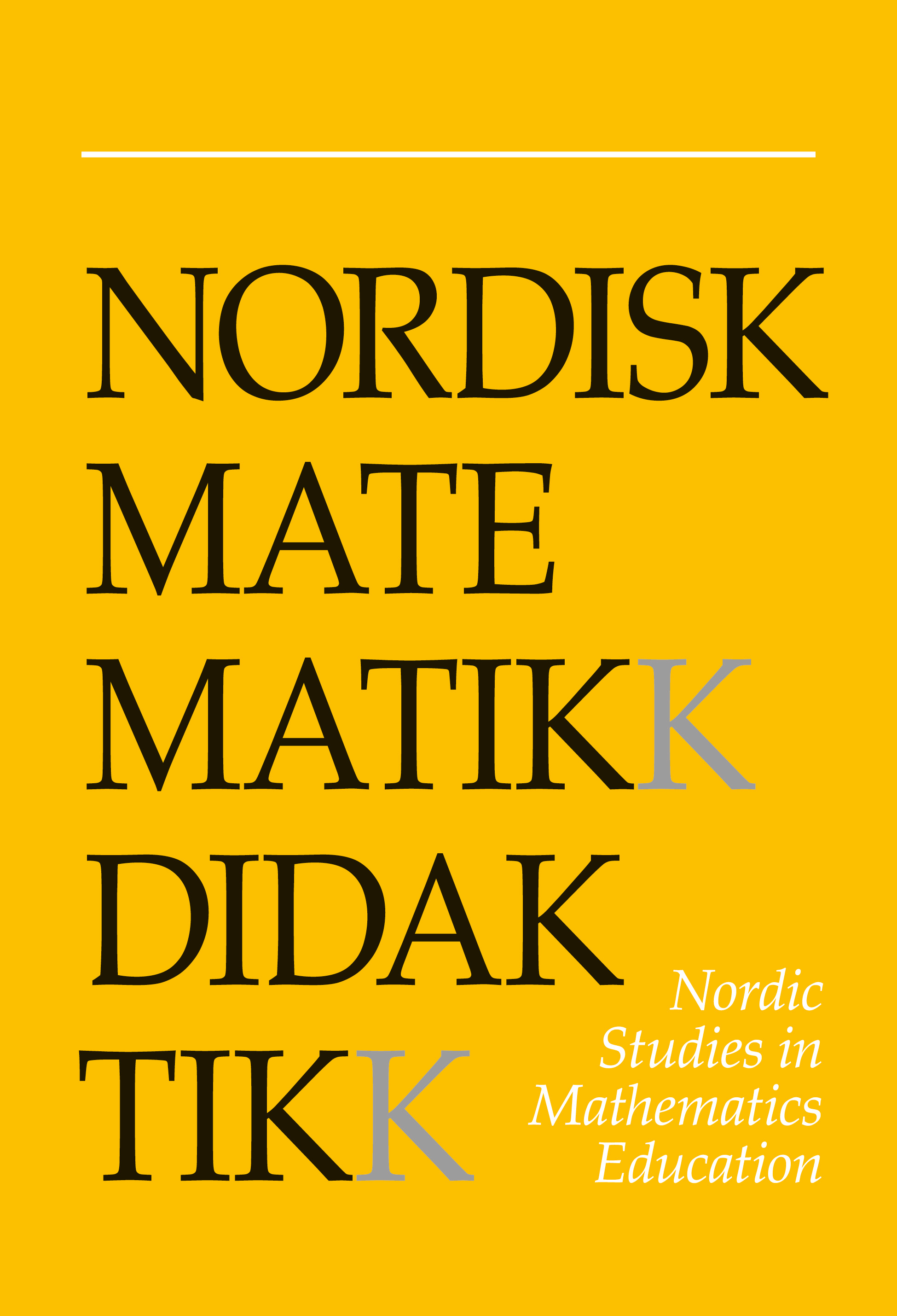Uncommon vocabulary in mathematical tasks in relation to demand of reading ability and solution frequency
DOI:
https://doi.org/10.7146/nomad.v20i1.148657Abstract
This study reports on the relation between commonness of the vocabulary used in mathematics tasks and aspects of students’ reading and solving of the tasks. The vocabulary in PISA tasks is analyzed according to how common the words are in a mathematical and an everyday context. The study examines correlations between different aspects of task difficulty and the presence of different types of uncommon vocabulary. The results show that the amount of words that are uncommon in both contexts are most important in relation to the reading and solving of the tasks. These words are not connected to the solution frequency of the task but to the demand of reading ability when solving the task.
References
Abedi, J. & Lord, C. (2001). The language factor in mathematics tests. Applied Measurement in Education, 14 (3), 219-234. https://doi.org/10.1207/S15324818AME1403_2
Austin, J. L. & Howson, A. G. (1979). Language and mathematical education. Educational Studies in Mathematics, 10, 161-197. https://doi.org/10.1007/BF00230986
Bergqvist, E., Dyrvold, A. & Österholm, M. (2012). Relating vocabulary in mathematical tasks to aspects of reading and solving. In C. Bergsten, E. Jablonka & M. Raman (Eds.), Evaluation and comparison of mathematical achievement: dimensions and perspectives. Proceedings of Madif 8 (pp. 61-70). Linköping: SMDF. Retrieved from http://urn.kb.se/resolve?urn=urn:nbn:se:umu:diva-51411
Bergqvist, E. & Österholm, M. (2010). A theoretical model of the connection between the process of reading and the process of solving mathematical tasks. In C. Bergsten, E. Jablonka & T. Wedege (Eds.), Mathematics and mathematics education: Cultural and social dimensions. Proceedings of MADIF 7 (pp. 47-57). Linköping: SMDF. Retrieved from http://urn.kb.se/resolve?urn=urn:nbn:se:umu:diva-31890
Dempster, E. R. & Reddy, V. (2007). Item readability and science achievement in TIMSS 2003 in South Africa. Science Education, 91, 906-925. https://doi.org/10.1002/sce.20225
Durkin, K. & Shire, B. (1991). Primary school children's interpretations of lexical ambiguity in mathematical descriptions. Journal of Research in Reading, 14 (1), 46-55. https://doi.org/10.1111/j.1467-9817.1991.tb00005.x
Halliday, M. A. K. (1978). Language as social semiotic: the social interpretation of language and meaning. London: Edward Arnold.
Hegarty, M., Mayer, R. E. & Monk, C. A. (1995). Comprehension of arithmetic word problems: a comparison of successful and unsuccessful problem solvers. Journal of Educational Psychology, 87 (1), 18-32. https://doi.org/10.1037/0022-0663.87.1.18
Helwig, R., Rozek-Tedesco, M. A., Tindal, G., Heath, B. & Almond, P. J. (1999). Reading as an access to mathematics problem solving on multiple-choice tests for sixth-grade students. The Journal of Educational Research, 93 (2), 113-125. https://doi.org/10.1080/00220679909597635
Homan, S., Hewitt, M. & Linder, J. (1994). The development and validation of a formula for measuring single-sentence test item readability. Journal of Educational Measurement, 31 (4), 349-358. https://doi.org/10.1111/j.1745-3984.1994.tb00452.x
Lindberg, I. & Kokkinakis, S. J. (Eds.). (2007). OrdiL - en korpusbaserad kartläggning av ordförrådet i läromedel för grundskolans senare år. University of Gothenburg. Retrieved from http://hdl.handle.net/2077/20503
Nation, K. (2005). Children's reading comprehension difficulties. In M. J. Snowling & C. Hulme (Eds.), The science of reading: a handbook (pp. 248- 265). Malden: Blackwell Publishing. https://doi.org/10.1002/9780470757642.ch14
NCTM. (2000). Principles and standards for school mathematics. Reston: National Council of Teachers of Mathematics.
Niss, M. & Højgaard, T. (Eds.). (2011). Competencies and mathematical learning: Ideas and inspiration for the development of mathematics teaching and learning in Denmark. Roskilde University. Retrieved from http://milne.ruc.dk/ImfufaTekster/pdf/485web_b.pdf
OECD. (2006). Assessing scientific, reading and mathematical literacy: a framework for PISA 2006. Paris: Author. https://doi.org/10.1787/9789264026407-en
O'Halloran, K. (2008). Mathematical discourse: language, symbolism and visual images. London: Continuum.
Pimm, D. (1989). Speaking mathematically: communication in mathematics classrooms (paperback edition). London: Routledge.
Schleppegrell, M. J. (2007). The linguistic challenges of mathematics teaching and learning: a research review. Reading & Writing Quarterly, 23 (2), 139-159. https://doi.org/10.1080/10573560601158461
Shaftel, J., Belton-Kocher, E., Glasnapp, D. & Poggio, J. (2006). The impact of language characteristics in mathematics test items on the performance of English language learners and students with disabilities. Educational Assessment, 11 (2), 105-126. https://doi.org/10.1207/s15326977ea1102_2
Shorrocks-Taylor, D. & Hargreaves, M. (2000). Measuring the language demands of mathematics tests: the case of the statutory tests for 11-year-olds in England and Wales. Assessment in Education, 7 (1), 39-60. https://doi.org/10.1080/713613324
Sinclair, J. (2005). Corpus and text - basic principles. In M. Wynne (Ed.), Developing linguistic corpora: a guide to good practice (pp. 5-24). Oxford: Oxbow books.
Stahl, S. A. (2003). Vocabulary and readability: how knowing word meanings affects comprehension. Topics in Language Disorder, 23 (3), 241-247. https://doi.org/10.1097/00011363-200307000-00009
Tabachnick, B. G. & Fidell, L. S. (2006). Using multivariate statistics (Vol. 5 rev. ed.). Boston: Allyn and Bacon.
Österholm, M. (2006). Characterizing reading comprehension of mathematical texts. Educational Studies in Mathematics, 63, 325-346. https://doi.org/10.1007/s10649-005-9016-y
Österholm, M. & Bergqvist, E. (2012a). Methodological issues when studying the relationship between reading and solving mathematical tasks. Nordic Studies in Mathematics Education, 17 (1), 5-30.
Österholm, M. & Bergqvist, E. (2012b). What mathematical task properties can cause an unnecessary demand of reading ability? In G. H. Gunnarsdóttir, F. Hreinsdóttir, G. Pálsdóttir, M. Hannula, M. Hannula-Sormunen, et al. (Eds.), Proceedings of Norma 11, the sixth Nordic Conference on Mathematics Education (pp. 661-670). Reykjavík: University of Iceland Press. Retrieved from http://urn.kb.se/resolve?urn=urn:nbn:se:umu:diva-39699
Österholm, M. & Bergqvist, E. (2013). What is so special about mathematical texts? Analyses of common claims in research literature and of properties of textbooks. ZDM - The International Journal on Mathematics Education, 45 (5), 751-763. https://doi.org/10.1007/s11858-013-0522-6
Downloads
Published
How to Cite
Issue
Section
License

This work is licensed under a Creative Commons Attribution-NonCommercial-ShareAlike 4.0 International License.



